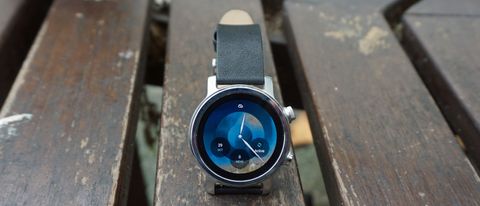TechRadar Verdict
The new Moto 360 is a fairly by-the-books Wear OS smartwatch, but uses its name, high price tag and a premium-esque appearance to masquerade as something more. Given the lack of many selling points beyond its operating system, the Moto 360 doesn’t quite justify its price tag, and given that Wear OS has its fair share of flaws, not everyone will find this smartwatch the best product for them.
Pros
- +
Familiar Wear OS
- +
Comes with multiple bands
- +
Always-on display
Cons
- -
Connectivity issues
- -
Short battery life
- -
Questionable design elements
Why you can trust TechRadar
The Moto 360 is back – in a way. The Moto 360 (2014) was one of the first smartwatches to feature a circular body, and its 2015 follow-up, the Moto 360, built on it in many ways, but after that Motorola appeared to give up on its wearable ambitions.
The newest Moto 360, launched at the end of 2019 but only becoming available in most countries in 2020, is made not by Motorola but by eBuyNow, under a licensing agreement – so this isn’t technically a Motorola smartwatch, and it follows the previous Moto 360 smartwatches in name and not much else.
Is the Moto 360, then, a crude attempt by a relatively unknown company to cash in on another brand’s name, and nostalgia for that brand’s products? Or is eBuyNow serious about becoming a player in the smartwatch market in its own right, and simply using the Moto branding as a springboard? Perhaps it’s a bit of both.
Price and availability
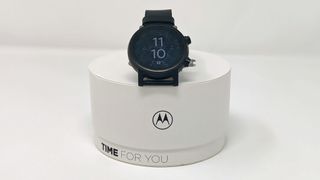
The Moto 360 price is a little on the high side: at $399 / £299 (roughly AU$550), it sits towards the top-end of Wear OS smartwatches, with only a few super-premium competitors costing more.
If you look at our list of the best Wear OS smartwatches, you’ll see that few of the best Google-OS-powered wearables even come close to this price tag. The Moto 360 will have to work hard to justify this high cost, then.
Looking outside the Wear OS sphere, the Moto 360 is a cheaper in some regions than the Apple Watch 5, which costs $399 / £399 / AU$649, although if you’re looking for a ‘traditional’ circular smartwatch the Samsung Galaxy Watch, which currently tops our list of the best smartwatches, launched for a slightly more affordable (depending on your region) $329 / £279 / AU$499, and costs even less now.
You can order the Moto 360 from the Moto 360 website, where it seems to be available in the UK, US and most of Europe. The phone is also available on Amazon in some regions, but given that the name is identical to its predecessors, which are still on sale, we’d recommend shopping from the Moto 360 website to avoid confusion. It doesn’t seem the smartwatch is available to buy in Australia.
Design
The Moto 360 consists of the main body and replaceable straps. In the box you’ll get both leather and silicone straps, which is good for people who use their watch for leisure and exercise, as you can swap between the two for each activity.

It also gives you an option if you don’t want to wear animal products – although the fact that you're still being forced to buy a leather strap may well be a deal-breaker.
The straps have plenty of perforations, so no matter if you’ve got a dainty or thick wrist, you’re going to have an easy time finding a comfortable fit. Both the buckle and the lugs feel secure, so there’s no worry of the Moto 360 flying off your wrist if you get a little overenthusiastic when working out.
Our review unit came with a black body and straps, but you can also order it with a stainless steel body and brown leather/black silicone straps, or a rose gold body with brown leather/white silicone straps. These latter two designs seem more lifestyle-focused than the black watch, which looks more like a fitness device.
The Moto 360 body itself is rather traditional-looking: it’s circular, with two crowns on the right side. The body is a little on the thick side at 11.68mm, so it stands out some way from the wrist – and this is despite the body not being very wide at 42.8 x 42.8mm, giving the watch a rather ‘rotund’ look.
Another curiosity in terms of design is the fact the Moto 360 body has a low bezel around it, but there’s also another black bezel inside this one, around the screen, so the watch face radius and actual screen size are fairly different.

There are two buttons on the right-hand edge of the watch. One is a rotating crown that takes you to the app list when pressed, and enables you to scroll through lists when you spin it with your finger, while the other is a button that can be mapped to a variety of functions.
Wearing the Moto 360 doesn’t feel too burdensome, despite its aforementioned girth and the fact that it weighs 52g, a little more than many smartwatches. We did find that it got caught in our sleeve now and then, likely due to its thickness, so depending on what you’re wearing you might find this an issue.
All in all the Moto 360 is a little thick, and has more bezel than it feels like it needs, but it’s not too heavy and feels secure and robust. We’re fans of the minimalist look too, although of course that’s a matter of taste.
Display
The Moto 360 screen is 1.2 inches across, and it’s an AMOLED display with a 390 x 390 resolution. This quality is pretty good for a smartwatch, and while you’re not going to be doing much that calls for a high-quality screen, the colors of icons and fitness readout graphs are bold and bright, which makes them easy to see outdoors.
The screen feels pretty responsive, and most of the time we felt like our touches and commands were registered accurately, but now and then we’d find that a swipe or press wasn’t picked up.
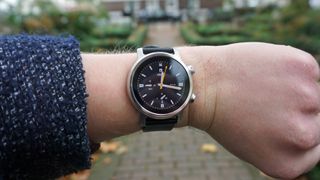
The Moto 360 has an always-on display, as on some other Wear OS and other smartwatches, which presents a more typically monochromatic watch face. This is useful in that it saves you having to turn on your smartwatch screen to check the time, but it does drain the battery fast.
We found the Moto 360 screen nice to use in general, but a little on the small side, as generally smartwatches have a 1.5-inch or bigger screen (that works out to 40mm, as smartwatch manufacturers tend to measure screen size in mm), and as a result the device can be a bit fiddly to use at times.
Fitness tracking
The Moto 360 is a Wear OS device, running Google’s smartwatch operating system, and we’ll get into that more later. The key thing when it comes to fitness tracking is that the watch links with Google Fit to track your day-to-day stats, as well as specific activities.
Generally, we found that steps and activity time were tracked fairly accurately, and we never felt that we’d done many more or fewer steps than the device suggested.
There are a range of specific workouts available through Google Fit too, from the more obvious ones such as walking, running and cycling, to fairly niche activities like stroller walking, sand running, cross-country skiing and horseback riding.
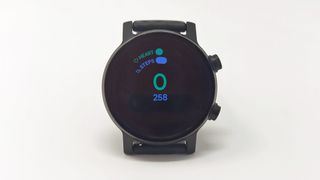
The total list is pretty overwhelming at almost 100 different sports tracked, and while detailed feedback isn’t available for all of these (for some it’s just heart-rate and time tracking), in some cases you’re presented with a veritable wealth of information.
For example, after a run you’ll be able to see your distance, time, pace, cadence, heart rate and other useful pieces of information. The feedback certainly isn’t as in-depth as it would be on a dedicated running watch, but Google Fit seems designed more for the average fitness enthusiast than for dedicated athletes.
It’s worth pointing out that the Moto 360 is 3ATM water resistant, according to the manufacturer, and this typically means the device is splashproof. eBuyNow states the device has been tested for 10,000 swim strokes too, despite not being 5ATM water resistant (which denotes that a device that can be used for swimming). This is a moot point, though, because there’s no actual swim-tracking mode, so we wouldn’t recommend buying the watch if you’re looking for something to track your water activities.
As well as Google Fit and Fit Workout, the app that houses those workout modes, there’s Fit Breathe, a breathing exercise app that’s as much a mindfulness tool as a meditative helper, and is similar to the apps you’ll find on other smartwatches and fitness trackers.
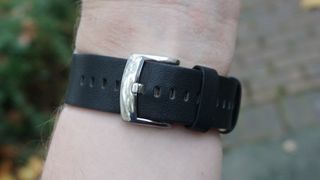
We didn’t test all the fitness modes on the Moto 360 and Google Fit – the sheer number of them would make that quite a tall order – but we’ve tested many of them across different Wear OS devices, and in general we can vouch for their usefulness.
While the Moto 360 offers a great range of fitness-tracking tools, the thickness of the device means we wouldn’t choose to use it for certain sports, like bouldering or boxing, as it could get snagged or pose a risk. Your mileage may vary, though.
Features and performance
The Moto 360 is powered by Qualcomm’s Wear 3100 chipset, the most advanced wearables processor from the company that makes tech for many top Android phones. The main advantage of this chipset is ostensibly improved battery life – although we’ll dispute this claim in the Battery Life section of this review – and also speedier navigation and general operation, which we found to be the case.
The Moto 360 feels fairly snappy to navigate, and you can generally navigate menus easily. There’s 1GB RAM here too, and 8GB of storage for apps and music, and we didn’t find the Moto 360 dragged too much when we’d filled it up a bit.
As mentioned, the Moto 360 operating system is Google’s Wear OS, and this is great if you’re already hooked up to the Android ecosystem (Android 6 or newer) with your phone and/or tablet. Apps like Google Pay for NFC payment, Google Fit for tracking activities, Google Maps for navigation on your wrist, and more, all make Wear OS devices feel as much like extensions of your smartphone as they do watches.
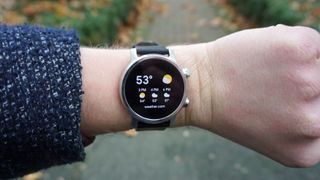
We’re not sure that Wear OS is as useful for people who don’t typically use Google’s apps, although you can link the Moto 360 to iPhones running iOS 10 or above.
We experienced a few bugs with Wear OS during our time with the Moto 360: for example, after turning on Theater Mode, which darkens the main screen but still lets you swipe to menus, and then deactivating the mode, our watch face wouldn’t return until we restarted the device. This was more of an irritation than a major issue, though.
Another bigger issue though, comes with the Moto 360’s connection to a smartphone. We used the watch alongside the Xiaomi Mi 10 Pro, and later the Motorola Edge, and found that our connection was frequently dropping. Moreover we couldn’t simply press a ‘reconnect’ button, but had to restart the phone to get the connection back.
After a while we found this more hassle than it was worth, and we had to simply put up with not getting notifications on our wrist, and not having workouts tracked on Google Fit and Strava sent to their respective phone apps. Needless to say, this really got in the way of our using the smartwatch, but we’d expect it’s something a software patch can fix.
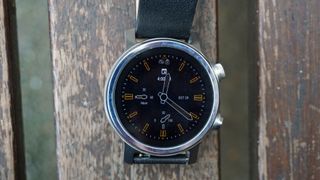
One of the key features of the Moto 360 is notification handling, and Wear OS stores these in a menu that you can access by swiping up on the main watch face. Notifications are brought in from your paired phone, and displayed on the watch; you can also reply using Google’s recommended suggestions, although in most cases you’re limited to ‘yes’, ‘no’ or ‘ok’, so in the case of messages it’s often easier to reply on your phone if you’ve got a longer response in mind.
Battery life
By far our biggest issue with the Moto 360 is its battery life, and it’s a complaint that’ll be familiar to many users of Wear OS watches, as they typically don’t last that long between charges.
The Moto 360’s 355mAh battery lasted up to a day, depending on what fitness features we used and how many notifications it had to handle. A 30 minute run drained the battery by up to 15%, and average use burned through 5-10% per hour – so an eight-hour work day with a half-hour run in the middle could leave us with a flat battery, or close to it.
When some smartwatches can go a week without being charged, it’s frustrating that we had to charge the Moto 360 daily – and even then we’d have to make sure to put it on charge before it died on us, as the battery life felt weak even for a Wear OS device.
There is a Battery Saver mode, which limits the Moto 360 to its bare time-telling functions. We don’t know exactly how much this extends the battery life by, but the feature automatically kicks in when the battery level is critical, and apparently in this mode the watch has a final three days of life.
The Moto 360 is charged via a dock that you plug into a USB port, and the Moto 360 clips to the dock magnetically. We plugged the USB into our laptop, which felt more convenient than using a USB adaptor plugged into the mains, although it was perhaps a little slower.
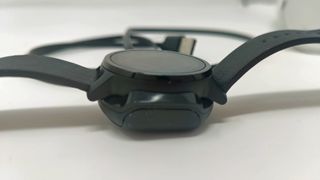
Unlike previous Moto 360 smartwatches there’s no wireless charging option here, and given that many new smartphones have reverse wireless charging, which enables you to use your handset to wirelessly charge other devices, this could have been a really useful feature.
We found a curious issue with charging, as while plugged in the Moto 360 would sometimes display different battery percentages when checked. On one occasion, 52 minutes after putting the watch on charge it was showing as 47%, but when we checked a minute later this had somehow rocketed up to 89%.
It felt as though that first reading was an error, although it was in line with numbers we’d seen on other occasions – in another instance, for example, 15 minutes on charge only powered the device up to 7%.
eBuyNow suggests the Moto 360 will charge from empty to 100% in an hour, and in our experience this appeared to be the case almost to the minute, notwithstanding the aforementioned anomaly. If you’re charging your device overnight though, as we suspect most people will need to, you’ll likely not care too much about speed.
Verdict
If you’re looking for a standard smartwatch that’ll give you access to Wear OS, the Moto 360 is just that – it’s not exactly full of unique features, and nor does it boast a particularly breathtaking design, but it’s certainly functional. Some might even like the design, especially the more colorful variants, but we found the double bezel and thickness a bit off-putting.
We would say that it’s not worth picking up the Moto 360 if battery life is a key consideration: if you’d rather not have to charge your device daily, or if you’re a heavy user, there are better devices available.
So eBuyNow’s first Moto watch isn’t terrible, and given that the company has licensing rights to produce more Moto 360 smartwatches until 2024, there are likely more to come. Hopefully it can resolve the issues with its first device, and make a few improvements, to create a genuinely impressive successor.

Tom Bedford was deputy phones editor on TechRadar until late 2022, having worked his way up from staff writer. Though he specialized in phones and tablets, he also took on other tech like electric scooters, smartwatches, fitness, mobile gaming and more. He is based in London, UK and now works for the entertainment site What To Watch.
He graduated in American Literature and Creative Writing from the University of East Anglia. Prior to working on TechRadar, he freelanced in tech, gaming and entertainment, and also spent many years working as a mixologist. He also currently works in film as a screenwriter, director and producer.
